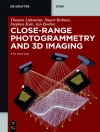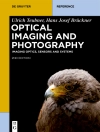Optical Fiber Sensing Technologies
Explore foundational and advanced topics in optical fiber sensing technologies
In Optical Fiber Sensing Technologies: Principles, Techniques, and Applications, a team of distinguished researchers delivers a comprehensive overview of all critical aspects of optical fiber sensing devices, systems, and technologies. The book moves from the basic principles of the technology to innovation methods and a broad range of applications, including Bragg grating sensing technology, intra-cavity laser gas sensing technology, optical coherence tomography, distributed vibration sensing, and acoustic sensing.
The accomplished authors bridge the gap between innovative new research in the field and practical engineering solutions, offering readers an unmatched source of practical, application-ready knowledge.
Ideal for anyone seeking to further the boundaries of the science of optical fiber sensing or the technological applications for which these techniques are used, Optical Fiber Sensing Technologies: Principles, Techniques, and Applications also includes:
- Thorough introductions to optical fiber and optical devices, as well as optical fiber Bragg grating sensing technology
- Practical discussions of Extrinsic-Fabry-Perot-Interferometer-based optical fiber sensing technology, acoustic sensing technology, and high-temperature sensing technology
- Comprehensive explorations of assemble free micro-interferometer-based optical fiber sensing technology
- In-depth examinations of optical fiber intra-cavity laser gas sensing technology
Perfect for applied and semiconductor physicists, Optical Fiber Sensing Technologies: Principles, Techniques, and Applications is also an invaluable resource for professionals working in the semiconductor, optical, and sensor industries, as well as materials scientists and engineers for measurement and control.
İçerik tablosu
Volume 1
Preface xiii
1 Optical Fiber and Optical Devices 1
1.1 Optical Fiber 1
1.2 Light Source 3
1.2.1 Semiconductor Laser 3
1.2.2 Optical Fiber Laser 6
1.3 Optical Amplifier 9
1.3.1 Erbium-Doped Fiber Amplifier 9
1.3.2 Semiconductor Optical Amplifier 12
1.4 Detector 14
1.5 Optical Fiber Passive Device 17
1.5.1 Optical Fiber Coupler 17
1.5.2 Optical Fiber Polarizer 18
1.5.3 Optical Fiber Isolator 19
1.5.4 Optical Fiber Circulator 20
1.5.5 Optical Fiber Switcher 22
1.5.5.1 Mechanical Optical Fiber Switcher 23
1.5.5.2 Solid Physical Effect-Based Optical Fiber Switcher 24
1.6 Optical Fiber Modulator 26
1.6.1 Optical Fiber Phase Modulator 26
1.6.2 Optical Fiber Intensity Modulator 27
References 28
Part I Discrete Optical Fiber Sensing 31
2 Optical Fiber Bragg Grating Sensing Technology 33
2.1 Principle of Fiber Bragg Grating Sensing 33
2.2 Photosensitivity of Ge-Doped Fiber 34
2.3 Fabrication of Fiber Bragg Grating 37
2.4 Package Design for Strain and Temperature Sensing 40
2.4.1 Package Design for Temperature Sensing 41
2.4.2 Package Design for Strain Sensing 44
2.4.3 Performance Evaluation Under Cryogenic Temperature 47
2.5 Demodulation of Fiber Bragg Grating Sensing for Space Application 55
2.5.1 Demodulation Theory of Fiber Bragg Grating Sensing 55
2.5.2 Demodulation Instrument Development 63
2.5.3 Effect of Environment Temperature Variation 64
2.5.4 Performance of FBG in Space Vacuum Thermal Environment 80
2.5.5 Cryogenic Static Measurement 84
References 90
3 Extrinsic Fabry–Pérot Interferometer-Based Optical Fiber Sensing Technology 93
3.1 Principle of Fabry–Pérot Interferometer 93
3.2 Fabry–Pérot Interferometer-Based Optical Fiber Sensor Structure 95
3.2.1 Fiber-Optic Intrinsic Fabry–Pérot Interferometer 95
3.2.1.1 IFPI Based on Reflective Film Coating on Fiber End 96
3.2.1.2 IFPI Based on UV-Induced Refractive Index Change 96
3.2.1.3 IFPI Based on Fusion Splicing of Different Kinds of Fibers 97
3.2.2 Fiber-Optic Extrinsic Fabry–Pérot Interferometer 98
3.2.2.1 EFPI Based on Capillary and Two Optical Fibers 99
3.2.2.2 EFPI Based on Diaphragm 100
3.2.2.3 EFPI Based on Air Gap in Fiber 101
3.2.2.4 EFPI Sensors Based on Angle-Polished Fiber End 102
3.2.2.5 EFPI Based on Transparent Medium 103
3.2.2.6 EFPI Based on In-Line Fiber Splicing 103
3.3 Optical Fiber Fabry–Pérot Interferometer Sensor Based on MEMS 104
3.3.1 Silicon-Diaphragm Optical Fiber Pressure Sensor 105
3.3.2 Temperature-Compensated Silicon-Based Optical Fiber Pressure Sensor 107
3.3.3 Non-intrusive Optical Fiber Sensor Head Chip Inspection 110
3.3.3.1 Self-Referenced Residual Pressure Measurement Method 111
3.3.3.2 Residual Pressure Self-Measurement Method 112
3.4 Polarization Low-Coherence Interference Demodulation for Pressure Sensing 114
3.4.1 Demodulation Theory 114
3.4.2 Demodulation Instrument 117
3.4.3 Demodulation Algorithm 118
3.4.4 Low-Coherence Interference Multiplexing 124
3.5 Application 129
3.5.1 Optical Fiber Pressure Sensing in Ocean Application 129
3.5.2 Optical Fiber Pressure Sensing in Aviation Application 129
References 132
4 Extrinsic Fabry–Perot Interferometer-Based Optical Fiber Acoustic Sensing Technology 137
4.1 Polymer Diaphragm Optical Fiber Acoustic Sensor 137
4.1.1 Basic Description of Fiber-Optic Fabry–Perot Acoustic Sensor 137
4.1.2 The Diaphragm Used for Optical Fiber Acoustic Sensing 137
4.2 Sensor Design and Parameters Optimization 138
4.2.1 Structure of Fiber-Optic Fabry–Perot Acoustic Vibration Sensor 138
4.2.2 Parameter Optimization of Sensor 140
4.3 Demodulation 141
4.3.1 Quadrature Phase Demodulation Theory 142
4.3.1.1 Principle of Dual-Laser Quadrature Phase Demodulation 143
4.3.1.2 Principle of Phase-Shifting Demodulation Using Birefringence Crystals 145
4.3.2 Dual-Laser Quadrature Phase Demodulation Instrument 153
4.3.3 Phase-Shifting Demodulation Instrument Using Birefringence Crystals 155
4.4 Optical Fiber Acoustic Sensing in Space Application 159
4.4.1 The Significance of Applying Optical Fiber Acoustic Sensor to Aerospace 159
4.4.2 Application of Optical Fiber Acoustic Vibration Sensor in Monitoring Requirement of Water Sublimator 160
4.4.3 Application of Optical Fiber Acoustic Sensor System in Low-Pressure Carbon Dioxide Environment 163
References 167
5 Extrinsic Fabry–Perot Interferometer-Based Optical Fiber High-Temperature Sensing Technology 169
5.1 Sapphire Material Characteristic 169
5.1.1 Optical Properties of Sapphire Crystal 169
5.1.2 Temperature Characteristics of Sapphire Crystal 171
5.1.2.1 Sapphire Fiber 171
5.1.3 Sapphire Wafer 172
5.2 Sapphire Fiber Fabry–Perot High-Temperature Sensor Design and Fabrication 173
5.2.1 Theory of Fiber Fabry–Perot High-Temperature Sensing 173
5.2.2 Fiber Coupling Model of Fabry–Perot Interference Signal 174
5.2.3 Temperature Characteristics of Sapphire Fabry–Perot Cavity 176
5.2.4 Sapphire Fiber and Multimode Fiber Beam Coupling Process 177
5.2.5 Sapphire Fiber Fabry–Perot High-Temperature Sensor Packaging Process 180
5.3 Sapphire Fiber Fabry–Perot High-Temperature Sensing Demodulation System 181
5.3.1 Sensing Demodulation System 181
5.3.2 Interference Spectrum Signal Characteristics of Sensing System 182
5.3.3 Influence of Spectral Distribution of Light Source on Peak Position of Interference Spectrum Signal 185
5.3.4 Typical Spectral Demodulation Principle 187
5.3.4.1 Single-Peak Demodulation 187
5.3.4.2 Dual-Peak Demodulation 189
5.3.4.3 Fourier Transform Demodulation 189
5.3.5 Demodulation Algorithm Based on Interferometric Spectral Phase Analysis 191
5.4 Analysis of Sensing Performance of Sapphire Fiber Fabry–Perot High-Temperature Sensor 192
5.4.1 Sensor Response Speed 193
5.4.2 Different Signal-to-Noise Ratios and Fabry–Perot Cavity Lengths 193
5.5 Self-Filtering High Fringe Contrast Sapphire Fiber Fabry–Perot High-Temperature Sensor 197
5.6 Summary 202
References 203
6 Assembly-Free Micro-interferometer-Based Optical Fiber Sensing Technology 207
6.1 Assembly-Free In-Fiber Micro-interferometer 207
6.2 Optical Fiber Sensor Based on Fiber Tip Micro-Michelson Interferometer 208
6.2.1 Principle of Optical Fiber Michelson Interferometer 208
6.2.2 Structure of Micro-Michelson Interferometer on a Fiber Tip 209
6.2.3 High-Temperature Sensing 211
6.3 Optical Fiber Sensor Based on In-Line Mach–Zehnder Interferometer 212
6.3.1 Principle of Optical Fiber Mach–Zehnder Interferometer 212
6.3.2 Structure of In-Line Mach–Zehnder Interferometer 213
6.3.3 In-Line Mach–Zehnder Interferometer Sensor 215
6.3.3.1 High-Temperature Sensor 216
6.3.3.2 Refractive Index Sensor 216
6.3.3.3 Strain Sensor 217
6.4 Optical Fiber Sensor Based on Fabry–Perot Interferometer 218
6.4.1 Principle of Optical Fiber Fabry–Perot Interferometer 218
6.4.1.1 Principle of Multiple-Beams Interference 218
6.4.1.2 Principle of Multiple-Cavity Interference 220
6.4.2 Structure of Fiber Fabry–Perot Interferometer 221
6.4.3 Fiber Fabry–Perot Interferometer Sensor 223
6.4.3.1 Refractive Index Sensor 223
6.4.3.2 Pressure and Strain Sensor 224
6.4.3.3 High-Temperature Sensor 224
6.4.3.4 Multiple-Parameter Sensor 225
6.5 Discussion and Conclusion 226
References 226
7 Surface Plasmon Resonance-Based Optical Fiber Sensing Technology 233
7.1 Coating of Optical Fiber 233
7.1.1 Physical Vapor Deposition 234
7.1.1.1 Sputter Deposition 234
7.1.1.2 Evaporation 234
7.1.1.3 The Holding Mechanism of the Optical Fiber in PVD 235
7.1.2 Chemical Liquid Phase Deposition 237
7.1.3 Metal Nanoparticles and Nanowires 238
7.2 Theoretical Modeling Multimode Optical Fiber Sensor Based on SPR 238
7.2.1 The Model 239
7.2.2 Experimental Verification 247
7.3 EMD-Based Filtering Algorithm 250
References 256
8 Sagnac Interferometer-Based Optical Fiber Sensing Technology 259
8.1 Principle of Sagnac Interferometer 259
8.2 Optical Fiber Gyroscope (FOG) 260
8.3 Optical Fiber Coil Quality Inspection Method 264
8.3.1 Optical Fiber Coil and its Winding Method 264
8.3.2 Polarization Crosstalk Measurement of Fiber Coils 267
8.3.2.1 The Principle of Polarization Crosstalk of PMF 268
8.3.2.2 The Principle of Distributed Polarization Crosstalk Measurements and Controls 269
8.3.2.3 PMF Coils Polarization Crosstalk Measurements and Controls 271
8.3.2.4 Raw PMFs Quality Testing 271
8.3.2.5 Online PMF Coils Polarization Crosstalk Measurements and Controls 272
8.3.2.6 Online Controls for Winding Tensions 273
8.3.2.7 Online Testing for Winding Symmetry 273
8.3.2.8 Overall PMF Coils’ Inspection 275
8.3.2.9 PMF Coils’ Technique Inspection 275
8.3.3 Transient Characteristics Measurement of Fiber Coils 276
8.3.3.1 Pointing Error Caused by Time-Dependent Radial Thermal Gradient 277
8.3.3.2 Experimental Result and Discussions of Transient Characteristics Measurement of Fiber Coils 281
8.3.4 Tomographic Inspection of Fiber Coils 286
8.3.4.1 Principle of Tomographic Inspection of Fiber Coils 287
8.4 Optical Fiber Current Sensing 291
References 294
9 Optical Fiber Sensors Based on the SMS Structure 303
9.1 Theory of SMS Fiber Structure 303
9.2 Characteristics of SMS Fiber Structure 307
9.2.1 Influence of the MMF Length 307
9.2.2 Influence of the Wavelength 311
9.2.3 Influence of Core Radius of the MMF 311
9.2.4 Influence of Refractive Indices of the MMF 313
9.3 Fiber Sensors Based on SMS Fiber Structure 319
9.3.1 Sensor Design and Fabrication 319
9.3.2 Refractive Index Sensors Based on SNS Fiber Structure 320
9.3.3 Temperature Sensors Based on SNS Structure 330
9.3.4 Magnetic Field Sensors Based on SNS or SMS Fiber Structure 331
9.3.4.1 Scalar Magnetic Field 331
9.3.4.2 Vector Magnetic Field 337
References 341
10 Whisper-Gallery-Mode-Based Hollow Microcavity Optical Fiber Sensing Technology 345
10.1 Whisper-Gallery-Mode Theory 345
10.2 Fabrication of Hollow Microcavity with Internal Air Pressure Control 349
10.2.1 Drawing System 350
10.2.2 Fabrication of Thin-Wall Micro-Capillary with Predetermined Radius 351
10.2.3 Fabrication of Hollow Microsphere with Wall-Thickness Control 355
10.3 Optical Fiber Magnetic Field Sensor Based on Thin-Wall Micro-Capillary and WGM 359
10.3.1 Magnetic Nanoparticle Assembly 359
10.3.2 Sensor Fabrication and Measurement 362
10.4 Optical Fiber High-Resolution Temperature Sensor Based on Hollow Microsphere and WGM 368
10.5 Ultraprecise Resonance Wavelength Determination Method 375
References 380
Volume 2
Preface xiii
Part II Special Discrete Optical Fiber Sensing and Network 383
11 Optical Fiber Intra-cavity Laser Gas Sensing Technology 385
12 Optical Fiber-Based Optical Coherence Tomography 437
13 Discrete Optical Fiber Sensing Network Technology 487
Part III Distributed Optical Fiber Sensing 537
14 Distributed Vibration Sensing Based on Dual Mach–Zehnder Interferometer 539
15 Regional Style Intelligent Perimeter Security Technique Based on Michelson Interferometer 595
16 Distributed Temperature Sensing Based on Raman Scattering 625
17 Distributed Acoustic Sensing Based on Optical Time-Domain Reflectometry 657
18 Distributed Sensing Based on Optical Frequency-Domain Reflectometry 709
19 Distributed Sensing Based on Brillouin Optical Correlation-Domain Analysis 771
Index 815
Yazar hakkında
Tiegen Liu, Ph D, is Professor in the School of Precision Instrument and Opto-Electronics Engineering at Tianjin University, China.
Junfeng Jiang, Ph D, is Professor in the School of Precision Instrument and Opto-Electronics Engineering at Tianjin University, China.
Kun Liu, Ph D, is Associate Professor in the School of Precision Instrument and Opto-Electronics Engineering at Tianjin University, China.
Shuang Wang, Ph D, is Assistant Professor in the School of Precision Instrument and Opto-Electronics Engineering at Tianjin University, China












